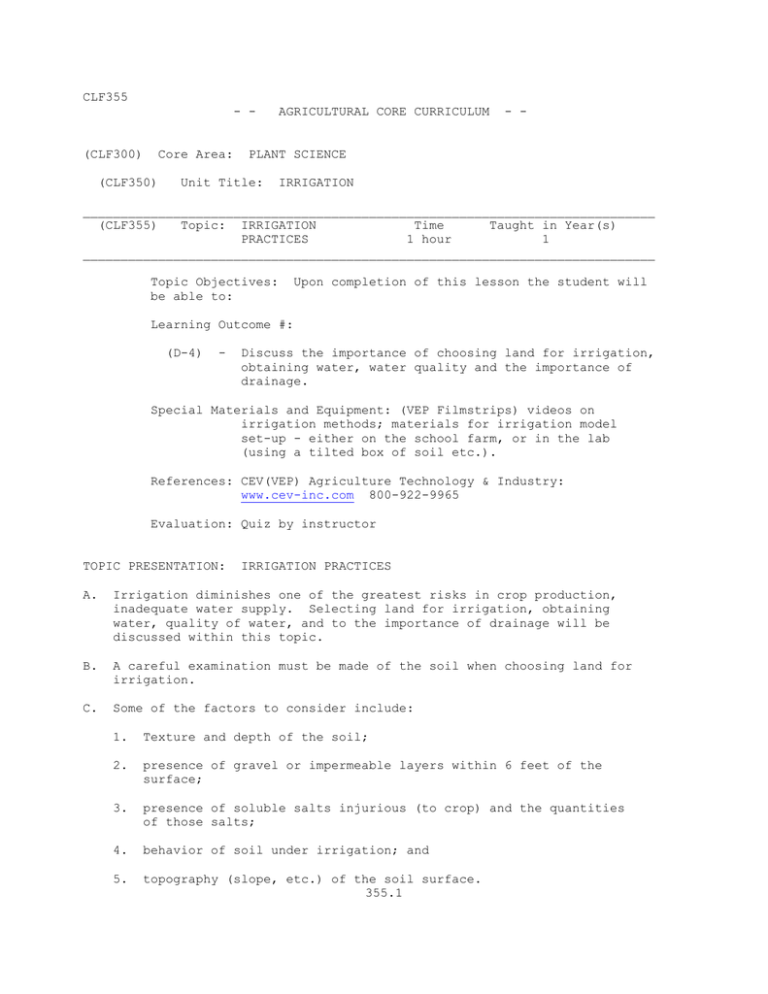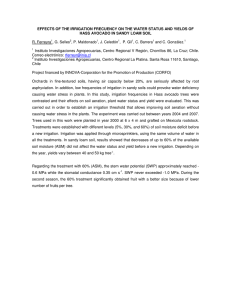CLF355
advertisement

CLF355 - (CLF300) Core Area: (CLF350) AGRICULTURAL CORE CURRICULUM - - PLANT SCIENCE Unit Title: IRRIGATION ____________________________________________________________________________ (CLF355) Topic: IRRIGATION Time Taught in Year(s) PRACTICES 1 hour 1 ____________________________________________________________________________ Topic Objectives: be able to: Upon completion of this lesson the student will Learning Outcome #: (D-4) - Discuss the importance of choosing land for irrigation, obtaining water, water quality and the importance of drainage. Special Materials and Equipment: (VEP Filmstrips) videos on irrigation methods; materials for irrigation model set-up - either on the school farm, or in the lab (using a tilted box of soil etc.). References: CEV(VEP) Agriculture Technology & Industry: www.cev-inc.com 800-922-9965 Evaluation: Quiz by instructor TOPIC PRESENTATION: IRRIGATION PRACTICES A. Irrigation diminishes one of the greatest risks in crop production, inadequate water supply. Selecting land for irrigation, obtaining water, quality of water, and to the importance of drainage will be discussed within this topic. B. A careful examination must be made of the soil when choosing land for irrigation. C. Some of the factors to consider include: 1. Texture and depth of the soil; 2. presence of gravel or impermeable layers within 6 feet of the surface; 3. presence of soluble salts injurious (to crop) and the quantities of those salts; 4. behavior of soil under irrigation; and 5. topography (slope, etc.) of the soil surface. 355.1 D. E. F. Most irrigation water of the world is surface water. 1. Usually this is obtained by building dams at higher elevations. 2. Runoff water from rainfall or melting snow provides the source. 3. A distribution system of canals, ditches, and pipelines delivers the water to the individual farm. 4. Often this type of irrigation project is built by the government. Payment for construction and maintenance is sometimes prorated to the landowners. 5. Only about 20 percent of the irrigation water in the U.S. comes from well water. Careful attention needs to be given to the quality of the available water before an irrigation system is built. 1. The presence of salts, especially sodium salts, in the water can cause soils to develop an undesirable structure. 2. This salinity can also be detrimental to plant growth if the concentration is high. 3. Some waters contain boron in sufficient quantities to become toxic to crop plants. 4. The effects of elements carried by the water on the crops grown will be determined by factors such as the salt content of the soil, soil texture, kind of clay minerals present and drainage. 5. The presence of organic matter and other suspended solids must be removed when using drip irrigation, otherwise it will clog the emitters. Providing proper drainage can produce several benefits. 1. Drainage can add additional volume of soil to the crops' root zone. 2. It can be used to flush out accumulated salts. 3. In some areas drainage can lower the water table, enabling roots to penetrate deeper. 4. Soil aeration, microbial action, and fertilizer efficiency are all improved by drainage. __________________________________________________________ ACTIVITY: 1. Use V.E.P filmstrips on irrigation. 2. Set up demonstration irrigation models on the school farm. 355.2 3. Build small irrigation systems using soil models in class. 4. Discuss the problems of salinity that face California agriculture and/or invite a water specialist in to discuss current water issues locally, regionally and statewide. __________________________________________________________ 355.3





